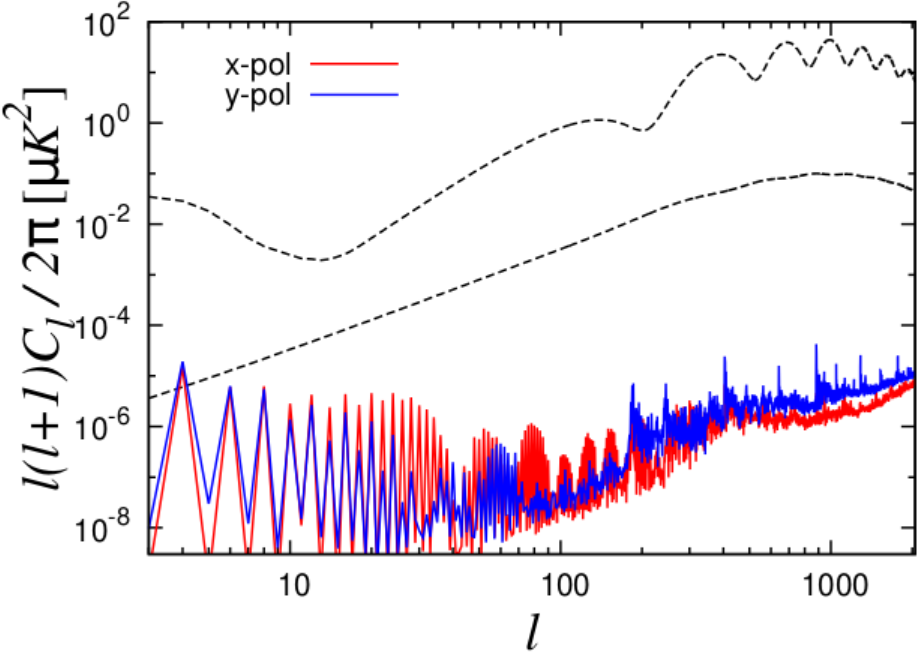Requirement analysis for LiteBIRD’s optical system
JAXA Supercomputer System Annual Report February 2023-January 2024
Report Number: R23EDU20199
Subject Category: Space and Astronautical Science
- Responsible Representative: Toru Yamada, Director, Institute of Space and Astronautical Science, Department of Space Astronomy and Astrophysics
- Contact Information: Ryo Nagata(nagata.ryo@jaxa.jp)
- Members: Ryo Nagata
Abstract
LiteBIRD is a strategic large-class mission being prepared by JAXA’s Institute of Space and Astronautical Science (ISAS) to observe in the frequency bands from 34 GHz to 448 GHz, extract polarization signals of the microwave background radiation, and make an all-sky map of them. By evaluating faint odd-parity patterns in the polarization map, we try to discover the primordial gravitational wave background that originated during the inflationary age of the universe. Since polarization signals originating from the primordial gravitational waves account for only a tiny fraction of the radiation the instruments receive, it is crucial to identify and mitigate systematic errors when we make their design requirements.
In the FY2023 activities, the study of sunlight leakage was advanced. The response of systematic errors to telescope sidelobe patterns was evaluated by simulating time-ordered data reflecting the moment-by-moment relationship between telescope pointing and sunlight incident angle. This year, we also conducted a preparatory study of how various systematic errors might manifest themselves in complex analysis at the final stage of the project. These efforts will help us better define the range of scientific results that LiteBIRD will achieve.
Reference URL
Please refer to ‘LiteBIRD: Lite (Light) satellite for the studies of B-mode polarization and Inflation from cosmic background Radiation Detection.‘.
Reasons and benefits of using JAXA Supercomputer System
The LiteBIRD project will make an all-sky polarization map of the microwave background radiation through scanning observations by the space telescope. In this study, we perform an entire suite of data analysis simulations from numerically generating time-ordered data to map reconstruction. The integration of beam-pattern convolution is performed on each sample of three-year data generated at a sampling rate of 19 Hz. We evaluate the beam function with an arcminute resolution at each sampling time. Repeating the coordinate transformations in projecting the beam properties to each point on the sphere is computationally demanding and requires integrated numerical resources. LiteBIRD was selected as an ISAS strategic large-class mission. The results of this study are reflected in its project documents as a basis of the optical design.
Achievements of the Year
LiteBIRD will make an all-sky map of the microwave background radiation polarization. Since its observation area must cover the entire sky, during the LiteBIRD’s scanning observation, the telescope is often tilted toward the Sun. The separation angle from the Sun varies periodically, synchronizing with the satellite spin, and reaches 85 degrees from the telescope pointing. (Figure 1) compares the systematic error caused by sunlight leakage through a far sidelobe with the microwave background radiation polarization for detectors located at the focal plane edge of Low-Frequency-Telescope. We can see that the diffraction of sunlight propagating through the side of the telescope appears as a large-angular structure on the map. Its scale exceeds ten degrees. The large-angular correlation in the polarization map can significantly influence the detection sensitivity of the primordial gravitational wave signal. Such a result can provide essential feedback for the design of telescope forebaffle geometry, etc.

Fig.1: Example of sunlight leakage due to a far sidelobe of Low-Frequency-Telescope. For a pixel located at the edge of its focal plane, the results are shown for a detector with its sensitivity parallel (x) to the scanning direction and also for that perpendicular (y).
Publications
N/A
Usage of JSS
Computational Information
- Process Parallelization Methods: MPI
- Thread Parallelization Methods: OpenMP
- Number of Processes: 96
- Elapsed Time per Case: 1.5 Hour(s)
JSS3 Resources Used
Fraction of Usage in Total Resources*1(%): 0.02
Details
Please refer to System Configuration of JSS3 for the system configuration and major specifications of JSS3.
| System Name | CPU Resources Used(Core x Hours) | Fraction of Usage*2(%) |
|---|---|---|
| TOKI-SORA | 631948.77 | 0.03 |
| TOKI-ST | 4469.33 | 0.00 |
| TOKI-GP | 0.00 | 0.00 |
| TOKI-XM | 0.00 | 0.00 |
| TOKI-LM | 1337.69 | 0.10 |
| TOKI-TST | 0.00 | 0.00 |
| TOKI-TGP | 0.00 | 0.00 |
| TOKI-TLM | 0.00 | 0.00 |
| File System Name | Storage Assigned(GiB) | Fraction of Usage*2(%) |
|---|---|---|
| /home | 0.00 | 0.00 |
| /data and /data2 | 6733.33 | 0.04 |
| /ssd | 0.00 | 0.00 |
| Archiver Name | Storage Used(TiB) | Fraction of Usage*2(%) |
|---|---|---|
| J-SPACE | 0.09 | 0.00 |
*1: Fraction of Usage in Total Resources: Weighted average of three resource types (Computing, File System, and Archiver).
*2: Fraction of Usage:Percentage of usage relative to each resource used in one year.
ISV Software Licenses Used
| ISV Software Licenses Used(Hours) | Fraction of Usage*2(%) | |
|---|---|---|
| ISV Software Licenses(Total) | 0.00 | 0.00 |
*2: Fraction of Usage:Percentage of usage relative to each resource used in one year.
JAXA Supercomputer System Annual Report February 2023-January 2024


